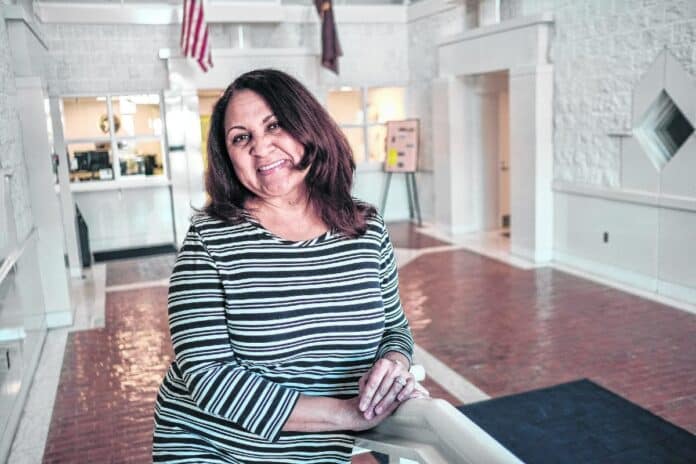
A new Bartholomew County Jail addiction treatment coordinator is spending her first months on the job creating a first-ever drug treatment program for jail inmates.
Although Bartholomew County Sheriff officials wanted an addiction treatment coordinator to be hired by last July. After a lengthy search, Theresa Patton took the job and started work on Oct. 22.
Despite the unexpected delay, the jail addiction treatment program quickly got back on schedule, said Chief Deputy Sheriff Maj. Chris Lane.
Inmate screenings are already underway for individuals to qualify for the program, actually beginning in mid-December, Lane said.
[sc:text-divider text-divider-title=”Story continues below gallery” ]
Patton, 58, a Chicago native who comes to Columbus from Indianapolis, credits the Alliance for Substance Abuse Progress (ASAP), the Bartholomew County Sheriff’s Department and Six Sigma efficiency expert Elizabeth Powers of Cummins Inc. for doing much of the advance work for the jail treatment program.
“They did the needs assessment,” Patton said. “They did all of the legwork that I would have eventually done.”
After spending her first month getting acquainted with community resources, Patton said she started to screen, classify and assess inmates while at the same time formulating a plan for drug treatment in the jail.
A challenging job
From group counseling, to counseling individual inmates and finding ways to assist them, the job of the program coordinator also entails developing a variety of ways of helping offenders, Patton said.
That could include assistance in remaining in recovery, finding jobs, developing life skills, improving parenting skills, leadership development, communication skills and family education.
While that may seem like a large agenda, Lane says he knows inmates who have told him they started using methamphetamine at the age of 12.
“Some of those same people are now 30, and have lived most of their life dependent on a substance to function,” Lane said. “So we have to essentially reprogram them, so when they get out of jail, they aren’t coming back.”
Patton is screening 22 female inmates for 12 available openings in the program. The reason that ‘ladies go first’ in this program is mainly for logistical purposes, as well as the fact that women tend to have greater problems such as seeking safety or needing trauma care, she said. Once all the female inmates are assessed, screening processes will begin to select 12 male inmates, Patton said.
Although the number of participants can be expanded if appropriate resources are secured, Patton said a total of 24 is the maximum during the program’s startup.
Separate but not privileged
Participants will be housed apart from the regular jail population in a section of the older part of the jail that was reopened last summer. Patton says that separation helps create a recovery environment that keeps the recovering individuals away from negative influences.
Previous efforts toward treating those with substance use disorder included 12-step programs including Alcoholics Anonymous or an approach called Recovery Works, Lane said.
“But after inmates came through these programs, they went right back to the regular inmate population, and the environment diminished or destroyed their progress,” Lane said.
Patton emphasized there will not be any pampering for those accepted into the program. Acceptance into the treatment program will not shorten an individual’s time behind bars nor serve as a “get out of jail” card, Patton said.
Part of that strategy is to weed out those who might be thinking of applying, but have no real desire to rid themselves of their addiction, Lane said.
But for those who are sincere about regaining sobriety, the program is probably the best chance most drug-addicted inmates will ever have to free themselves from mind-altering substances, Patton and Lane said.
“It’s a gift they are being given to actually change their behavior through understanding their individual conditions, and all they really need to do is seek the opportunity,” Patton said.
Patton says she developed her perspectives after working at private residential care facilities, when she describes as highly prohibitive and far beyond the financial resources of most people who are incarcerated.
The drug treatment coordinator position at the local jail is appealing to her because the patients are in involuntary confinement, rather than residential care, she said.
“When you have people who are with you all the time, you are able to do the most amount of good,” Patton said. “But when people come and go at their leisure, that can play havoc with the way you are trying to provide treatment.”
Individualized programs
The program that Patton is developing for the jail is based on the patient placement criteria developed by the American Society of Addiction Medicine (ASAM).
Criteria provides treatment plans developed through multidimensional patient assessments. Patton says she will soon receive software that will greatly assist her in developing individual assessments that will help her determine the most effective path toward guiding an participant away from drug relapses or committing additional offenses.
“Some (inmates) may need child care or a GED,” she said. “That might be better served with the ASAP Hub,” referring to the 2,000 square-foot recovery resource center located at the Doug Otto United Way building which opened last year.
However, some might require intensive outpatient treatment after leaving the Bartholomew County Jail, while others are more in need of housing — which she says is the most difficult service to provide inmates who are recovering from addiction.
“Every person is different, and one size does not fit all,” Patton said. “What I expect is a collaboration of partners capable of handling different needs.”
The new jail addictions treatment program is not connected with the “Women Recovering with a Purpose” (WRAP) or the “Recovery Enables a Life for Men” (REALM) programs, Lane emphasized. While both WRAP and REALM may be housed in the same building as the jail, those two programs are part of Bartholomew County Community Corrections — not the jail.
In addition, Patton said the treatment program she’s developing will provide more intense, comprehensive and long-standing treatments than are currently offered by WRAP or REALM.
Those who believe the new program will provide quick solutions for addiction treatment will be disappointed, Lane said.
“The real show of what our work is going to be will come when individuals who have completed this program have moved on to other things without repeating an offense or resuming drug use,” Lane said. “That’s when we’re going to try to figure out what we did right,” he said, and learn what needs to be improved.
It could take as long as three to five years before the community really starts getting feedback from those who have been through the program, and learn how it redirected them off the addiction path and back into the path of becoming productive citizens, Lane said.
[sc:pullout-title pullout-title=”Theresa Patton” ][sc:pullout-text-begin]
Age: 58
Hometown: Chicago, Illinois
Education: Bachelor of science degree from Eureka College in Illinois. Master of science degree in clinical addictions counseling, with a minor in psycho-pharmacy, from Governors State University in University Park, Illinois in 1996.
Professional experience: Began as trainer in hospital emergency rooms. Worked in child, adolescent and adult psychology. Following certifications, she became a substance abuse professional for the U.S. Department of Transportation.
Children: Son, Ron, 27; daughter, Camille, 25.
[sc:pullout-text-end][sc:pullout-title pullout-title=”Six dimensions of treatment ” ][sc:pullout-text-begin]
The addiction treatment program at the Bartholomew County Jail will be based on six dimensions designed to create a holistic, biopsychosocial assessment of an individual for planning and treatment across all services and levels of care.
The six dimensions developed by the American Society of Addiction Medicine deal with the exploration of:
- An individual’s past and current experiences of substance use and withdrawal.
- A person’s health history and current physical condition.
- An inmate’s thoughts, emotions and mental health issues.
- An individual’s readiness and interest in changing.
- An inmate’s unique relationship with relapse or continued use or problems.
- A person’s recovery or living situation, and the surrounding people, places or things.
Source: American Society of Addiction Medicine
[sc:pullout-text-end]




